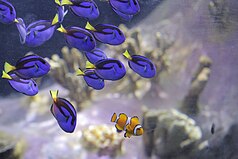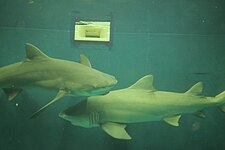National Marine Aquarium, Plymouth
 Entrance to the National Marine Aquarium | |
| Date opened | 1998[1] |
|---|---|
| Location | Plymouth, England |
| Coordinates | 50°22′00″N 4°07′53″W / 50.3666°N 4.1313°WCoordinates: 50°22′00″N 4°07′53″W / 50.3666°N 4.1313°W |
| No. of animals | 4,000 |
| No. of species | 400 |
| Volume of largest tank | 2,500,000 l (660,000 US gal) |
| Memberships | BIAZA[2] |
| Major exhibits | 4 main zones |
| Website | www |
This section contains content that is written like an advertisement. (July 2021) |
The National Marine Aquarium, located in Britain's Ocean City Plymouth is the largest Aquarium in the UK. It is home to over 4,000 animals and has carried out "groundbreaking" Ocean conservation work,[3] as well as offering a variety of immersive and engaging opportunities to learn about the marine environment through ocean education for all ages.
The National Marine Aquarium is also run by the Ocean Conservation Trust, a charity dedicated to connecting people with the Ocean.
The marine aquarium is located in Sutton Harbor, next to the Barbican and fish market. It was opened in May 1998,[1] with charitable aims of research, education and conservation. It is a member of the British and Irish Association of Zoos and Aquariums (BIAZA).
Exhibits
The Aquarium is divided into four main zones: Plymouth Sound, British Coasts, Atlantic Ocean and Blue Planet.
Plymouth Sound
This zone displays marine life found around Plymouth. It concentrates on the range of habitats found around the city. There are 17 tanks, which are home to approximately 80 species of fish and invertebrates, including local sharks, rays, seahorse and octopus.
Eddystone Reef
The second exhibit is the largest native offering in Britain, housing life-size models of whales and dolphins located around Britain. The large Eddystone tank displays an array of creatures found on the Eddystone reef, 19 km south of Plymouth. Through a huge window, visitors can see conger eels, mullet(fish), pollack, bream, and smooth hound sharks swimming in the open water, flatfish and rays hiding on the seabed, and lobsters and crabs hiding in the rocks.
Atlantic Ocean
This zone contains various areas within, including 'Ocean Drifters', 'Ocean Lab', 'Observation Deck', 'Lost at Sea' and 'Ocean Predators'. The 'Ocean Drifters' jellyfish exhibit was opened in 2009, and includes moon jellies, Japanese sea nettles, and Upside-down jellyfish, housed in round tanks to prevent damage to their delicate bodies. The other areas take you around the largest tank of the aquarium housing 1,000 Caribbean fish including nurse shark, lemon shark, sand tiger shark, zebra shark, sandbar shark, barracuda, southern stingray, tarpon, turtle. The tank volume is 2.5 million litres. This exhibit was updated at the end of 2009, with the largest ever shipment of live fish into the UK, from Barbados, West Indies. It was updated again in 2015/16 with the addition of Lemon and sand-tiger sharks.
The Laboratory
The Laboratory allows you to see what life is like working behind the scenes at the aquarium. Biologists can be seen taking care of the younger generation of species being bred and cared for before entering the main exhibits.
Blue Planet
This zone includes 'Biozone' and the 'Great Barrier Reef'. Biozone showcases the amazing biodiversity found in the world's oceans and displays species such as the longhorn cowfish, lionfish, Giant Pacific Octopus Enteroctopus dofleini and seahorses. This zone also includes the second largest tank at 700,000 liters, home to over 70 species of fish. It also was the home of the loggerhead sea turtle, Snorkel, who was with the aquarium from 1990 to 2016.
Conservation
The National Marine Aquarium is a dedicated charity that drives marine conservation through engagement. They led a project to sink frigate HMS Scylla in 2004 to create an artificial reef in Whitsand Bay, Cornwall.[4] It is the lead partner in Just Add H2O, a schools learning center,[5] which also offers outreach programs based around the National Curriculum teaching 30,000 school children each year. Through National Marine Aquarium grants, smaller charities can further help with driving marine conservation.
References
- ^ a b "National Marine Aquarium". historyofplymouth.co.uk. Plymouth Places. Archived from the original on 17 August 2011. Retrieved 22 February 2011.
- ^ "BIAZA Zoos and Aquariums". biaza.org.uk. BIAZA. Retrieved 21 February 2011.
- ^ "About the National Marine Aquarium | The UK's Largest Aquarium". National Marine Aquarium. Retrieved 22 March 2022.
- ^ wrecktoreef Web site:Artifical reef has generated millions for the Cornish economy, 7 April 2014
- ^ "National Marine Aquarium School Trips & Workshops". www.planmyschooltrip.co.uk. Retrieved 22 March 2022.
External links
 Media related to National Marine Aquarium at Wikimedia Commons
Media related to National Marine Aquarium at Wikimedia Commons- Official website
- Articles with short description
- Short description with empty Wikidata description
- Use dmy dates from September 2020
- Coordinates not on Wikidata
- Articles with a promotional tone from July 2021
- All articles with a promotional tone
- Commons category link is locally defined
- Official website not in Wikidata
- Aquaria in England
- Buildings and structures in Plymouth, Devon
- Oceanaria
- Tourist attractions in Plymouth, Devon
- Wind power in England
- Wind power in the United Kingdom








